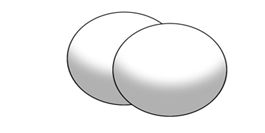Lesson two
PRINCIPLES OF ART
These are the guidelines used to arrange and organize the elements of art in order to produce a satisfactory piece of Art work.
1. Balance
This is the state of equilibrium between elements used in a composition. This allows every item or unit on a surface to have a degree of attraction. Balance has been categorized into;
a. Symmetrical/formal/passive balance.
This is a type of balance that is achieved when the opposite parts of a given art work in respect to the vertical or horizontal axis are exactly or nearly the same. Balance across the middle creates formal unity in a composition and guides a feeling of stability and uniformity.
b. Asymmetrical/informal/active.
This is a type of balance that does not weigh equally on both sides of an art work i.e. balanced by elements which are not identical.
c. Radial balance.
This is a type of balance where the elements are equally distributed from the centre to the outer area; the centre becomes a potential focal point. Radial balance can either be symmetrical or asymmetrical.
2. Rhythm
This refers to the visual movement in an art work i.e. a flowing movement having a regularly repeated pattern or elements of art such as line, form, texture and colour.
How to achieve rhythm
i. Repetition.
Rhythm can be achieved by repetition of similar elements which are placed together at regular intervals throughout the composition.
ii. Alternation.
This is created by arranging elements to follow each other alternatively e.g. an angular shape and circular shape may be alternated both in shape and size.
iii. Progression.
This is achieved when the flow of elements gradually changes in a sequence. Forms appear in an orderly sequence which creates rhythm and movement.
iv. By manipulating the pose portrayed in a given artwork especially if the objects are in a natural setting.
3. Dominance/emphasis.
This is developing a point of interest in an artwork, it can be achieved in the following ways
i. Contrast. Stronger tones dominate weak ones
ii. By using shapes. Bigger shapes always dominate smaller ones.
It is the making of an area stand out in a composition.
4. Proportion
This refers to the relationship of parts of something as compared to another. It is used in a composition on how different forms relate to each other in a natural setting e.g. size of the human head as compared to `the leg
5. Harmony
This refers to the relationship of elements i.e. how they relate to each other in shape, colour, tone, texture and value. The closeness in the relationship between these elements binds the composition together and gives the elements a feeling of togetherness.
6. Unity
This is the harmonious balance of elements in such a way that they create the effect of oneness in the composition.
7. Contrast
This is the juxtaposition of different elements in a composition. It creates excitement and interest, and often draws the eye to certain areas in an artwork.
Perspective. This is the illusion change in shape, size and form created by objects due to the effect of distance. Perspective is used to create a feeling or illusion of depth on a two dimension surface. This makes objects that are closer to the viewer appear bigger than those at a distance.
Variety is created when different elements are displayed in composition so as to break monotony and create excitement.
HOW TO CREATE PERSPECTIVE
- By Overlapping
This is when one object close to the viewer covers part of a nearby or second object.

2. By Size variation.
Near large objects are made to seem closer to the viewer than smaller objects even though there on the same level.
